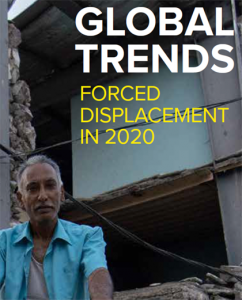Human displacement continues to rise despite COVID lockdowns – UN report
The number of people forced to flee their homes because of war, violence, persecution and human rights violations has risen to 82.4 million over the past year, according to a new report from the UN’s refugee agency UNHCR.
The agency says in its latest ‘Global Trends’ report that almost three million more people were forced to flee their homes last year, even though the COVID-19 crisis restricted movement worldwide as countries shut borders and ordered lockdowns.
UN High Commissioner for Refugees Filippo Grandi said conflict and the impact of climate change in places such as Mozambique, Ethiopia’s Tigray region and Africa’s Sahel area were among the leading sources of new movements of refugees and internally displaced people in 2020.
And he urged world leaders to step up their efforts to foster peace, stability and cooperation in order to halt and begin reversing nearly a decade-long trend of surging displacement driven by violence and persecution. The report shows that by the end of 2020 there were 20.7 million refugees under UNHCR mandate, 5.7 million Palestine refugees and 3.9 million Venezuelans displaced abroad.
The report shows that by the end of 2020 there were 20.7 million refugees under UNHCR mandate, 5.7 million Palestine refugees and 3.9 million Venezuelans displaced abroad.
Another 48 million people were internally displaced (IDPs) within their own countries. And 4.1 million more people were asylum-seekers.
“These numbers indicate that despite the pandemic and calls for a global ceasefire, conflict continued to chase people from their homes,” the report says.
“Behind each number is a person forced from their home and a story of displacement, dispossession and suffering. They merit our attention and support not just with humanitarian aid, but in finding solutions to their plight,” it says.
Mr Grandi said that while the 1951 Refugee Convention and the Global Compact on Refugees provides the legal framework and tools to respond to displacement, there is a need for much greater political will to address conflicts and persecution that force people to flee in the first place.
“Girls and boys under the age of 18 account for 42 per cent of all forcibly displaced people. They are particularly vulnerable, especially when crises continue for years. New UNHCR estimates show that almost one million children were born as refugees between 2018 and 2020. Many of them may remain refugees for years to come,” Mr Grandi said.
“The tragedy of so many children being born into exile should be reason enough to make far greater efforts to prevent and end conflict and violence,” he said.
The report reveals that at the peak of the pandemic in 2020, over 160 countries had closed their borders, with making no exception for people seeking protection.
Yet with improved measures – such as medical screenings at borders, health certification or temporary quarantine upon arrival, simplified registration procedures and remote interviewing, more and more countries found ways to ensure access to asylum while trying to stem the spread of the pandemic.
While people continued to flee across borders, millions more were displaced within their own countries, the report says.
Driven mostly by crises in Ethiopia, Sudan, Sahel countries, Mozambique, Yemen, Afghanistan and Colombia the number of internally displaced people rose by more than 2.3 million.
Over the course of 2020, some 3.2 million IDPs and just 251,000 refugees returned to their homes – a 40 and 21 per cent drop, respectively, compared to 2019.
Another 33,800 refugees were naturalised by their countries of asylum. Refugee resettlement registered a drastic drop – just 34,400 refugees were resettled last year, the lowest level in 20 years.
The report said this was a consequence of reduced number of resettlement places and COVID-19.
“Solutions require global leaders and those with influence to put aside their differences, end an egoistic approach to politics, and instead focus on preventing and solving conflict and ensuring respect for human rights,” Mr Grandi said.
Key Findings
The report said there were 82.4 million people forcibly displaced globally, up 4 per cent from 79.5 million in 2019.
The number includes 26.4 million refugees, up from 26 million in 2019, and includes 20.7 million refugees under UNHCR’s mandate, up from 20.4 million in 2019.
There are 5.7 million Palestine refugees under UNRWA’s mandate, up from 5.6 million in 2019.
Internally displaced persons (IDPs) number 48, up from 45.7 million in 2019.’
There are 4.1 million asylum-seekers, 3.9 million Venezuelans displaced abroad, up from 3.6 million in 2019.
The report says that 2020 is the ninth year of uninterrupted rise in forced displacement worldwide.
This means that currently, one per cent of humanity is displaced and there are twice as many forcibly displaced people than in 2011 when the total was just under 40 million.
The report says more than two thirds of all people who fled abroad came from just five countries: Syria (6.7 million), Venezuela (4.0 million), Afghanistan (2.6 million), South Sudan (2.2 million) and Myanmar (1.1 million).
It says the vast majority of world’s refugees – nearly nine in 10 refugees (86 per cent) – are hosted by countries neighbouring crises areas and low and middle-income countries.
Least Developed Countries provided asylum to 27 per cent of the total.
For the seventh year in a row, Turkey hosted the largest refugee population worldwide with 3.7 million refugees, followed by Colombia with 1.7 million (mostly displaced Venezuelans, Pakistan with 1.4 million, Uganda with 1.4 million, and Germany with 1.2 million.
The report said pending asylum applications globally remained at 2019 levels with 4.1 million.
But individual countries and UNHCR collectively registered some 1.3 million asylum applications, one million fewer than in 2019, or 43 per cent less.
Read the full Global Trends report here: https://www.unhcr.org/60b638e37/unhcr-global-trends-2020












